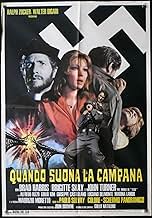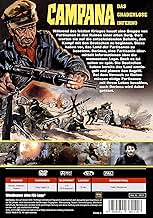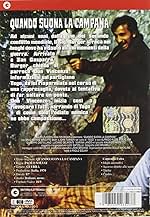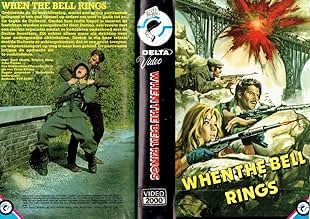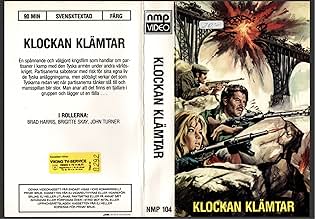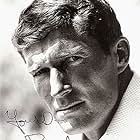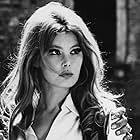Aggiungi una trama nella tua linguaDuring the Second World War, a group of Greek partisans fight against Germans.Tego is one of them, unfortunately he encounters atrocities at the hands of the Nazis and loses his family,wonde... Leggi tuttoDuring the Second World War, a group of Greek partisans fight against Germans.Tego is one of them, unfortunately he encounters atrocities at the hands of the Nazis and loses his family,wonders the countryside then dies.During the Second World War, a group of Greek partisans fight against Germans.Tego is one of them, unfortunately he encounters atrocities at the hands of the Nazis and loses his family,wonders the countryside then dies.
Gino Turini
- Tego
- (as John Turner)
Benito Pacifico
- Partisan
- (non citato nei titoli originali)
Xiro Papas
- Partisan
- (non citato nei titoli originali)
Trama
Lo sapevi?
- ConnessioniEdited into La bestia in calore (1977)
Recensione in evidenza
I am a stalwart defender of the Euro War sub genre from 1967 - 1970 or so. In the wake of the success of THE DIRTY DOZEN, GUNS OF NAVARONE, THE LONGEST DAY and THE GREAT ESCAPE a number of Italian & Spanish distributors contracted their producers and directors to churn out about 60 - 75 (the precise number is not clear) of WW2 themed potboiler quickies using the same sets, casts, locations, technical crews, and directors as their Spaghetti Western industry. And the best of the examples -- or at least the most watchable/enjoyable -- have the same cartoonishly throwaway feel as a Spaghetti Western. COMMANDOS, FIVE FOR HELL, HELL IN NORMANDY, DESERT COMMANDOS, THE WAR DEVILS, SALT IN THE WOUND: They may not have been particularly well-made or socially relevant (what would German collaborators really have to say about WW2 anyway, except maybe they weren't as awful as the Nazis?) but are enjoyable escapist fantasy fare aimed straight at the bloodthirsty 12 year old boy in all of us who likes watching stuff get blown up real good. They were Spaghetti Westerns with tanks + machine guns instead of horses + six shooters, and while many were downright absurd they do have a certain charm about them that is very reminiscent of "playing army" as a kid out in the sand lot near the lake house with your cousins. The stories are disposable, the plots re-usable, and the films for the most part unremarkable, made for little or no money, meant to be shown on a double bill one week then gone the next, replaced by 2 more just like it. The Italians may not have crafted particularly memorable films, but you have to admit that they kept busy, and for the most part the Euro War phenomenon resulted in fast paced if somewhat derivative & formulaic efforts that nonetheless had a certain entertainment value that sadly was lost on North American audiences. Aside from COMMANDOS and FIVE FOR HELL they are obscure, unheard of, and incredibly hard to find other than a few crummy public domain releases of tattered, worn full frame TV prints that were rescued from various trash dumpsters after the local TV movie matinée years ended.
One of the films you won't find, however, is WHEN THE BELL TOLLS. I have been criticized for being "lenient" when it comes to evaluating Euro cult genre cinema before, and the war films in particular, but this time I won't mince words: This movie SUCKS. Even the presence of Brad "Zambo" Harris cannot add much interest, beyond noting that the film features a performance by Brad "Zambo" Harris (one of my favorites of the genre actors) as a priest. He appears in the bookend segments of the film, of which the first (running about 15 minutes) is the only part of the movie with any genuine interest. The rest is utterly excruciating, and not even in a good way. The film was directed by Luigi Batzella aka Paul Solvay, who also wrote and adapted his story for the screenplay and thusly has nobody else but himself to blame. Batzella would later go on to bigger & better things as a sometimes brilliant director of erotic Euro Horror -- his "Nude for Satan" and especially "The Devil's Wedding Night" are two of that genre's finest efforts, and little of the promise seen in those movies is evident here. There is perhaps an autobiographical nature to the film, which is all I can think of to explain what a slogging, indulgent, and uninteresting mess of a narrative it attempts to tell. I have sat through it twice and both times failed to understand what the point of it was. Like the good Sgt. Slaughter points out, the movie consists of a series of seemingly random, unconnected set pieces that appear to be parts of different movies, and are so ineptly staged and executed as to make one wonder if this may have been some kind of a put-on or tax dodge.
From what I could make of it, the story is about a would-be priest who encounters atrocities at the hands of the Nazis, goes insane, wanders the countryside moaning and screaming and gabbering like a madman, eventually meets up with a group of Spanish or Italian partisans, and then dies. Just how the film gets from point A to B to C is confused, as if large sections of a longer movie are missing, or perhaps a misguided attempt at surrealism was intended. Much of the middle section of the film was shot with some sort of a colored filter on the camera lens, suggesting that it's either supposed to be interpreted as a flashback or what this insane cleric is witnessing -- Either way it doesn't make any sense and after about an hour becomes so annoying as to be distracting. The film opens and closes with Father Harris reminiscing about his former colleague with one of their former Nazi foes, a device which might normally have worked to explain what it all means but here only has the effect of reminding us how cool it *WOULD* have been to see Brad "Zambo" Harris taking on the Nazis single handedly & cracking skulls with Gianni Garko or Enzo Girolami. Coulda shoulda woulda. It's also odd to note that Batzella and Harris would re-team in 1976 for the infamous THE BEAST IN THE HEAT -- which recycles much of the battle footage from this movie, and others -- perhaps the most notorious of the Italian Nazi Exploitation Trash sub genre, and what is amazing about it is that it's actually a better movie than WHEN THE BELL TOLLS once you get down to it. Which wasn't an easy feat to pull off.
Defies any kind of a "star" rating system: Anyone who manages to find a copy and watches it all the way through deserves some kind of a medal.
One of the films you won't find, however, is WHEN THE BELL TOLLS. I have been criticized for being "lenient" when it comes to evaluating Euro cult genre cinema before, and the war films in particular, but this time I won't mince words: This movie SUCKS. Even the presence of Brad "Zambo" Harris cannot add much interest, beyond noting that the film features a performance by Brad "Zambo" Harris (one of my favorites of the genre actors) as a priest. He appears in the bookend segments of the film, of which the first (running about 15 minutes) is the only part of the movie with any genuine interest. The rest is utterly excruciating, and not even in a good way. The film was directed by Luigi Batzella aka Paul Solvay, who also wrote and adapted his story for the screenplay and thusly has nobody else but himself to blame. Batzella would later go on to bigger & better things as a sometimes brilliant director of erotic Euro Horror -- his "Nude for Satan" and especially "The Devil's Wedding Night" are two of that genre's finest efforts, and little of the promise seen in those movies is evident here. There is perhaps an autobiographical nature to the film, which is all I can think of to explain what a slogging, indulgent, and uninteresting mess of a narrative it attempts to tell. I have sat through it twice and both times failed to understand what the point of it was. Like the good Sgt. Slaughter points out, the movie consists of a series of seemingly random, unconnected set pieces that appear to be parts of different movies, and are so ineptly staged and executed as to make one wonder if this may have been some kind of a put-on or tax dodge.
From what I could make of it, the story is about a would-be priest who encounters atrocities at the hands of the Nazis, goes insane, wanders the countryside moaning and screaming and gabbering like a madman, eventually meets up with a group of Spanish or Italian partisans, and then dies. Just how the film gets from point A to B to C is confused, as if large sections of a longer movie are missing, or perhaps a misguided attempt at surrealism was intended. Much of the middle section of the film was shot with some sort of a colored filter on the camera lens, suggesting that it's either supposed to be interpreted as a flashback or what this insane cleric is witnessing -- Either way it doesn't make any sense and after about an hour becomes so annoying as to be distracting. The film opens and closes with Father Harris reminiscing about his former colleague with one of their former Nazi foes, a device which might normally have worked to explain what it all means but here only has the effect of reminding us how cool it *WOULD* have been to see Brad "Zambo" Harris taking on the Nazis single handedly & cracking skulls with Gianni Garko or Enzo Girolami. Coulda shoulda woulda. It's also odd to note that Batzella and Harris would re-team in 1976 for the infamous THE BEAST IN THE HEAT -- which recycles much of the battle footage from this movie, and others -- perhaps the most notorious of the Italian Nazi Exploitation Trash sub genre, and what is amazing about it is that it's actually a better movie than WHEN THE BELL TOLLS once you get down to it. Which wasn't an easy feat to pull off.
Defies any kind of a "star" rating system: Anyone who manages to find a copy and watches it all the way through deserves some kind of a medal.
- Steve_Nyland
- 13 lug 2006
- Permalink
I più visti
Accedi per valutare e creare un elenco di titoli salvati per ottenere consigli personalizzati
Dettagli
- Data di uscita
- Paese di origine
- Lingua
- Celebre anche come
- When the Bell Tolls
- Azienda produttrice
- Vedi altri crediti dell’azienda su IMDbPro
Contribuisci a questa pagina
Suggerisci una modifica o aggiungi i contenuti mancanti

Divario superiore
By what name was Quando suona la campana (1970) officially released in Canada in English?
Rispondi
